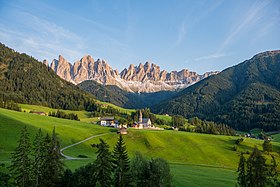Dolomites
The Dolomites (Italian: Dolomiti [doloˈmiːti]),[note 1] also known as the Dolomite Mountains, Dolomite Alps or Dolomitic Alps, are a mountain range in Northeast Italy. They are in Veneto, Trentino-Alto Adige/Südtirol and Friuli-Venezia Giulia.
 Valley of Funes, 2018 | |
| Elevation | 3,343 m (10,968 ft) |
|---|---|
| Pronunciation | [doloˈmiːti] |
| Location | |
| Geology | |
| Age of rock | Mostly Triassic |
On 26 June 2009, the Dolomites became a UNESCO World Heritage Site.[1][2]
Etymology
The mountain range is called "Dolomites" because it is made of dolomite for the most part.
Geography
There are many shorter ranges within Dolomites.
- Antelao
- Bosconero
- Cadini Group
- Civetta
- Cristallo Group
- Fanes Group
- Friulian Dolomites
- Geisler Group
- Langkofel Group
- Latemar
- Lüsen Mountains
- Marmarole
- Marmolada
- Pala
- Peitlerkofel Group
- Pelmo
- Prags Dolomites
- Puez Group
- Rosengarten Group
- Schiara
- Schlern Group
- Sella
- Sexten Dolomites
- Tofane
- Vette Feltrine
Tourism and sports
People visit the Dolomites not only to see them, but also to practice many sports. During winter, people go skiing and they do other winter sports.[3] In summer, they go rock climbing, hiking, cycling, paragliding and many more.[4]
Major peaks
- Marmolada – 3,343 m (10,968 ft)
- Antelao – 3,264 m (10,709 ft)
- Tofana di Mezzo – 3,241 m (10,633 ft)
- Sorapiss – 3,229 m (10,594 ft)
- Cristallo – 3,221 m (10,568 ft)
- Monte Civetta – 3,220 m (10,560 ft)
- Cima di Vezzana – 3,192 m (10,472 ft)
- Cimon della Pala – 3,184 m (10,446 ft)
- Langkofel / Sassolungo – 3,181 m (10,436 ft)
- Monte Pelmo – 3,168 m (10,394 ft)
Major passes
- Ombretta Pass – 2,738 m (8,983 ft)
- Langkofeljoch – 2,683 m (8,802 ft)
- Tschagerjoch – 2,644 m (8,675 ft)
- Grasleiten Pass – 2,597 m (8,520 ft)
- Pravitale Pass – 2,580 m (8,460 ft)
- Comelle Pass – 2,579 m (8,461 ft)
- Rosetta Pass – 2,573 m (8,442 ft)
- Vajolet Pass – 2,549 m (8,363 ft)
- Canali Pass – 2,497 m (8,192 ft)
- Tierseralpljoch – 2,455 m (8,054 ft)
Parks
- Adamello Brenta Natural Park – 62,051 ha (153,330 acres)
- Friulian Dolomites Natural Park – 36,950 ha (91,300 acres)
- Naturpark Fanes-Sennes-Prags – 25,485 ha (62,970 acres)
- Paneveggio-Pale di San Martino Natural Park – 19,726 ha (48,740 acres)
- Naturpark Sextener Dolomiten – 11,600 ha (29,000 acres)
- Ampezzo Dolomites Natural Park – 11,200 ha (28,000 acres)
- Puez-Geisler Nature Park – 10,196 ha (25,190 acres)
- Schlern-Rosengarten Nature Park – 6,796 ha (16,790 acres)
- Dolomiti Bellunesi National Park – 3,200 ha (7,900 acres)
Dolomites Media
Tofana massif with Cortina d'Ampezzo in the foreground
Notes
- ↑ Ladin: Dolomites; German: Dolomiten [doloˈmiːtn̩] ( listen) ("Dolomiten" in Langenscheidt German-English Dictionary); Venetian: Dołomiti [doɰoˈmiti]; Friulian: Dolomitis
References
- ↑ "The Dolomites UNESCO World Heritage Site". Dolomites UNESCO World Heritage (in English, Deutsch, and italiano). Retrieved 22 April 2024.
- ↑ "The Dolomites". UNESCO (in English, français, العربية, español, 日本語, and Nederlands). Retrieved 22 April 2024.
- ↑ Koch, Amy Tara (25 November 2019). "Hut Skiing in the Dolomites: Storybook Scenery and Grappa Included". The New York Times. Retrieved 22 April 2024.
- ↑ Draper, Robert (13 August 2015). "In Italy, Hiking and Haute Cuisine in the Dolomites". The New York Times. Retrieved 22 April 2024.